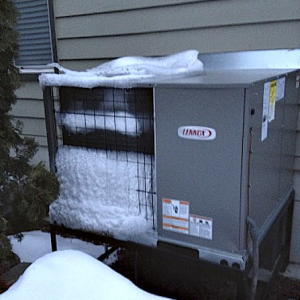 In my travels around the valley taking care of clients during the winter, I’ve noticed a number of significant issues that have been occurring. One of the more significant problems and most expensive for repairs has been the toll that our winter weather takes on the various heating systems. During my inspections, I can often hear unusual compressor and fan motor noises indicating that these components are under undue stress. Upon closer inspection, I am amazed that these systems can even continue to operate. The bottom line is that these systems are potentially incurring significant damage and shortened lives for a variety of reasons explained below.
In my travels around the valley taking care of clients during the winter, I’ve noticed a number of significant issues that have been occurring. One of the more significant problems and most expensive for repairs has been the toll that our winter weather takes on the various heating systems. During my inspections, I can often hear unusual compressor and fan motor noises indicating that these components are under undue stress. Upon closer inspection, I am amazed that these systems can even continue to operate. The bottom line is that these systems are potentially incurring significant damage and shortened lives for a variety of reasons explained below.
The first thing to understand is that heat pumps need to have no restrictions in airflow in order to operate efficiently and achieve 15 to 20 year average life spans. Without proper airflow, lifespans can be shortened from 1/3 to 1/2 of average time. Airflow is critical not only through clean and frequently changed filters, but also necessary through all evaporator and condenser coils. The pictures you see here are some examples of fans and condenser coils that have been completely blocked by snow and ice resulting in very minimal to no air flow. The fans at the top function to draw air in across the lower condenser coils in order for the proper heat exchange to occur between the refrigerant in these coils and the outside air. This is essential for delivering the correct amount of heat needed for the interior of the home. Without this airflow, compressors and fan motors eventually burn out.
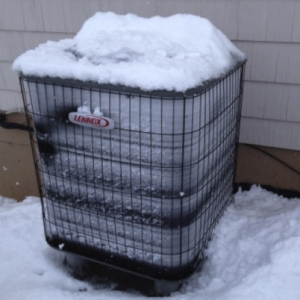 The second issue is that under proper operating conditions with good airflow, heat pumps periodically enter into defrost cycles resulting in melted snow and ice draining down to the bottom and then out of the unit onto the ground. When the bottom of the heat pump is either buried in snow or sitting down in a well or hole, this defrost water has nowhere to go. Also, as this picture demonstrates, snow again covers the condenser coils blocking more of the needed airflow. Consequently, the heat pump builds up successive layers of ice until it starts to look like one of the Winterfest Ice Sculptures. Again, this is not a good thing for insuring the longevity of these units. One of my clients now understands why they needed to replace their heat pump compressor after less than 5 years. It too was subjected to numerous episodes of snow coverage and ice buildup. Another friend of mine just spent over $ 3000 replacing his damaged compressor simply because he failed to change his air filter every 3 months. Mind you, none of these were cheap learning experiences. Since those experiences, I’ve set my clients up on a program to monitor their equipment; change filters on schedule and implement emergency steps to protect the equipment when weather changes
The second issue is that under proper operating conditions with good airflow, heat pumps periodically enter into defrost cycles resulting in melted snow and ice draining down to the bottom and then out of the unit onto the ground. When the bottom of the heat pump is either buried in snow or sitting down in a well or hole, this defrost water has nowhere to go. Also, as this picture demonstrates, snow again covers the condenser coils blocking more of the needed airflow. Consequently, the heat pump builds up successive layers of ice until it starts to look like one of the Winterfest Ice Sculptures. Again, this is not a good thing for insuring the longevity of these units. One of my clients now understands why they needed to replace their heat pump compressor after less than 5 years. It too was subjected to numerous episodes of snow coverage and ice buildup. Another friend of mine just spent over $ 3000 replacing his damaged compressor simply because he failed to change his air filter every 3 months. Mind you, none of these were cheap learning experiences. Since those experiences, I’ve set my clients up on a program to monitor their equipment; change filters on schedule and implement emergency steps to protect the equipment when weather changes 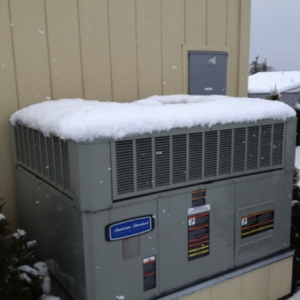 occur or if other issues are noted during my regular inspections. Most of us have experienced Murphy’s Law that states: “Anything that can go wrong will go wrong”. This principle was certainly in effect for many of these systems.
occur or if other issues are noted during my regular inspections. Most of us have experienced Murphy’s Law that states: “Anything that can go wrong will go wrong”. This principle was certainly in effect for many of these systems.
Cold weather generally will bring out the lion’s share of problems with heat pumps and heating systems. All components of the heat pump need to be properly 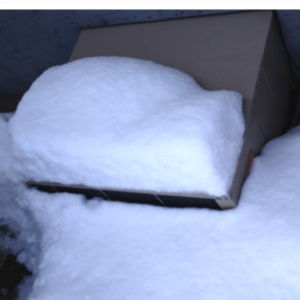 functioning in order for the unit to work effectively and efficiently. During cold and adverse weather, this equipment needs to be vigilantly monitored and immediate steps taken to prevent serious damage. In cases of heavy snow and ice storms, heat pumps need to be manually switched over to Emergency Heat settings to protect units from icing and freezing up. Power outages also can wreak havoc on compressors by turning the normal vapor refrigerant back into a liquid state. Compressors unfortunately were not designed to handle liquid refrigerant. Specific steps need to be taken when power outages occur to prevent refrigerant flooding of compressors. Unfortunately, most power outages also occur in winter when there is no one around to take the required steps to protect this expensive equipment. Of course, when these heating systems fail, then there are many other issues with potential interior damage from frozen water pipes, cracked furniture, damaged electronics and flooded homes when temperatures do warm up again.
functioning in order for the unit to work effectively and efficiently. During cold and adverse weather, this equipment needs to be vigilantly monitored and immediate steps taken to prevent serious damage. In cases of heavy snow and ice storms, heat pumps need to be manually switched over to Emergency Heat settings to protect units from icing and freezing up. Power outages also can wreak havoc on compressors by turning the normal vapor refrigerant back into a liquid state. Compressors unfortunately were not designed to handle liquid refrigerant. Specific steps need to be taken when power outages occur to prevent refrigerant flooding of compressors. Unfortunately, most power outages also occur in winter when there is no one around to take the required steps to protect this expensive equipment. Of course, when these heating systems fail, then there are many other issues with potential interior damage from frozen water pipes, cracked furniture, damaged electronics and flooded homes when temperatures do warm up again.
Here are series of important tips from other websites that I came across that I would like to share with you.
HEAT PUMP ONLY TIPS:
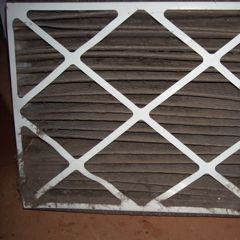 Keep snow, ice, plants, shrubs and leaves away from the outdoor unit. This includes the top, sides, and bottom of the unit.
Keep snow, ice, plants, shrubs and leaves away from the outdoor unit. This includes the top, sides, and bottom of the unit.- Need to inspect the outdoor heat pump frequently during the winter months for signs of excessive ice or snow build-up on, in or around the heat pump, especially after bad weather. If the unit is covered in snow or ice, it must be removed promptly for it to work properly. The thermostat also needs to be manually switched to Emergency Heat or the Off position while removing the snow and ice. You can pour warm water over the unit to melt the snow and ice and even cold water from a hose will help. Avoid using any sharp objects to pick or knock of the ice from the coils. This can cause severe damage to the unit and possible personal injury. Once the unit is clear of snow and ice, turn the thermostat back to normal heating mode and monitor if the unit ices up again. Professional service needs to be scheduled if icing continues since this indicates other system problems.
- Heat Pumps should be elevated 4 to 8 inches above ground level to keep coils clear of snow and ice and to allow for proper drainage. Again, during periods of heavy snowfall, you should immediately clear the area around the base and bottom coils of the outside unit and inspect for icing and take immediate action steps to safeguard the components.
- Filters should be monitored and replaced when dirty or not less than manufacturer’s recommended time intervals. The lack of proper airflow on the return air side can also result in serious damage to compressors. This too can contribute to refrigerant flooding damage of compressors.
- During power outages, heat pumps should be switched over to Emergency Heat, especially during cold weather, to prevent refrigerant flooding of compressors which can severely damage these compressors once power is restored. Once power has been restored, you should wait at least 1 ½ hours per ton of cooling capacity before switching back to normal operation to allow refrigerant to return to vapor state.
- Power outages and restoration can also cause surges or spikes in the incoming voltage which can damage sensitive electronics as well as relay switches in all heating systems resulting in potential permanent loss of heat from both heat pump and non-heat pump systems. The same can occur with electrical storms. It is extremely important to monitor and take precautionary steps during any of these events and to check operation of systems after these occurrences.
For those of you interested in setting up a comprehensive program of monitoring and management of your home systems, Lake Chelan HomeWatch provides this service to the Chelan Valley area. We monitor over 90 different categories of components on home systems to identify or minimize problems, such as those described above, before these become severe and result in greater expense and inconvenience to you. Heating, plumbing and building envelope systems are only part of the critical areas that we inspect on a weekly or twice a month basis. Feel free to Contact Us if we can provide any assistance.
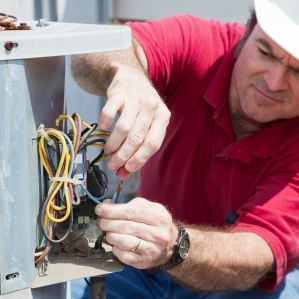 With our extensive construction experience, we can also arrange, and meet with specialty contractors to perform more technical services to insure that your systems are properly corrected and then further monitor them to make sure that the performed work solved the underlying problems. Essentially, we are your eyes, ears, nose and feet while you are away and we act as your advocate to insure that your property is handled with the same care as our own home.
With our extensive construction experience, we can also arrange, and meet with specialty contractors to perform more technical services to insure that your systems are properly corrected and then further monitor them to make sure that the performed work solved the underlying problems. Essentially, we are your eyes, ears, nose and feet while you are away and we act as your advocate to insure that your property is handled with the same care as our own home.
For those of you with RV’s, we also have a step by step inspection checklist/management system that we utilize to keep those systems properly monitored and functioning. For more information, please Contact Us.

Recent Comments